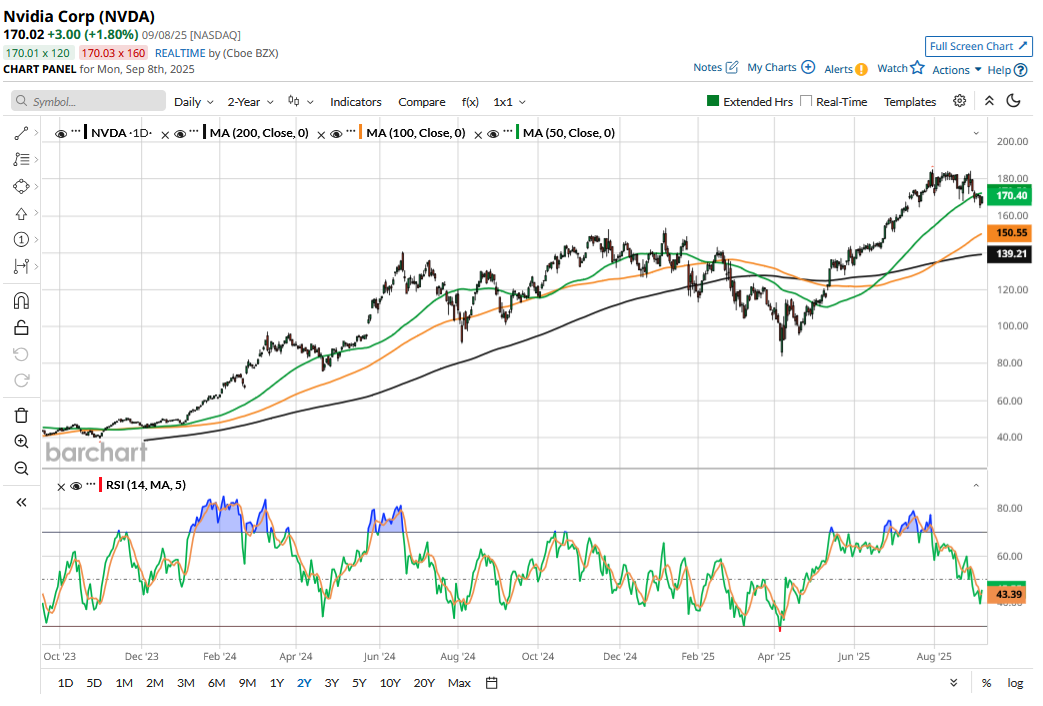/NVIDIA%20Corp%20logo%20on%20phone-by%20Evolf%20via%20Shutterstock.jpg)
Nvidia stock (NVDA) has looked weak since the company released its fiscal Q2 2026 earnings last month. As has invariably been the case over the last few quarters, NVDA stock fell despite the company beating on both the top line and the bottom line.
Contrary to what I had expected, Nvidia stock has continued its losing streak and came closer to abandoning its coveted $4 trillion market cap amid the recent selloff. While the stock has faced much worse drawdowns over the last three years, its rally is currently facing a reality check, as we’ll explore in this article.

Why Nvidia Stock Is Going Down
As I have noted previously, Nvidia faces several risks. These include a slowdown in artificial intelligence (AI) capex or tech companies’ inability to monetize their AI capex, the possibility of other chipmakers rivalling its dominance in the AI chip market, and uncertainty over its China business.
As things stand today, tech companies are only doubling down on AI capex and have shown encouraging signs of monetization, even as these are arguably early days. That said, the other two risk factors are pretty much in play right now.
While Nvidia has literally had a home run in AI chips, competition might finally be catching up, and Broadcom (AVGO) has signed a $10 billion deal for a custom AI chip, reportedly with OpenAI. Hyperscalers, including Amazon (AMZN), have been working on custom AI chips for quite some time now, but Broadcom’s deal with the officially unnamed customer is perhaps the first warning sign for Nvidia.
On a similar note, Chinese companies like Cambricon, Alibaba (BABA), and Huawei are aspiring to fill Nvidia’s role in the Chinese market. Chinese AI startup DeepSeek, which created waves with its cheap AI model earlier this year, has hinted that its latest AI model will be supported by domestic chips.
Nvidia’s China Business Is in the Doldrums
Notably, China is the world’s second-largest market for AI chips, and Nvidia CEO Jensen Huang sees it as a $50 billion opportunity this year. Importantly, he foresees the Chinese AI chip market growing by 50% annually, which is much faster than the global average.
President Donald Trump has allowed Nvidia to resume exports of H20 chips, which it had specifically designed for China. Nvidia said that it could ship H20 chips worth between $2 billion-$5 billion this quarter in China, subject to regulatory clearances. However, it added that it could ship more if there is higher interest from Chinese customers or if more licenses are issued by the U.S. government.
However, China has cautioned domestic companies against using these chips, flagging safety concerns over possible “backdoors.”
Comments from Trump and other cabinet members over the H20 being inferior to the chips that Nvidia sells within the U.S. are not helping matters. During the fiscal Q2 earnings call, Nvidia CFO Colette Kress said that Nvidia is “still waiting on several of the geopolitical issues going back and forth between the [U.S. and Chinese] governments and the companies trying to determine their purchases and what they want to do.”
NVDA Stock Forecast
Sell-side analysts have invariably been bumping up Nvidia’s target prices over the last two years to play catch-up with its price action. However, there are signs of brokerages getting a bit dicey, and Citi has lowered its target price today by $10 to $200, today, Sept. 8, citing the revenue hit from Broadcom. The overall Street sentiment remains bullish, though, and NVDA’s mean target price of $211.53 is 24.4% higher than current price levels.
Is Nvidia Stock a Buy or a Sell?
For perhaps the first time since the AI revolution began in 2023, Nvidia is facing some real competition in the U.S. as well as China. To be sure, China has been a wild card for Nvidia for the last few quarters, and the company did not assume any H20 revenues from China in its fiscal Q3 guidance.
So far, Nvidia has been able to offset the loss of China business due to strong growth elsewhere, which helped it deliver a 56% year-over-year revenue increase in the most recent quarter.
As for Broadcom onboarding a $10 billion revenue client, I believe the AI story is far from over, and there is space for “companies not named Nvidia” to grab a piece of the pie, given the expected growth. For context, Huang sees global AI infrastructure spending rising to between $3 trillion and $4 trillion by the end of this decade.
All said, I am not too perturbed by the rising competition in the AI chip space, at least for now, and will continue to stay put in the stock even as I don’t find the current price levels attractive enough to trigger a fresh purchase.
On the date of publication, Mohit Oberoi had a position in: NVDL , AMZN , BABA . All information and data in this article is solely for informational purposes. For more information please view the Barchart Disclosure Policy here.






